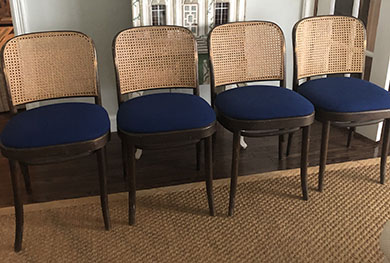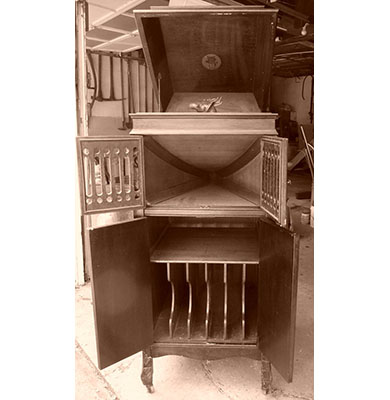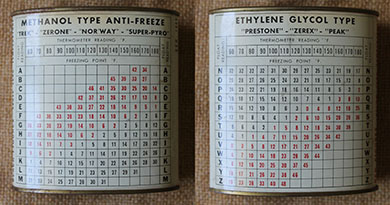 |
|
|||
 |
 |
|||
RINKER ON COLLECTIBLES — Column #1717 Copyright © Harry Rinker, LLC 2019 Questions
and Answers
QUESTION: I own four Thonet banquet dining room side chairs. The chairs feature a caned bentwood back that is rounded at the top corners The modified saddle seats have a blue fabric stretched across a urethane foam cushion that is attached to a seat frame. There is a branded “THONET” on the bottom of the seat frame. A tag on the bottom reads: “MANUFACTURED BY / THONET INDUSTRIES, INC.” “391 EAST PRINCESS STREET / FACTORY: STATESVILLE, NC” under “THONET.” “YORK, PA” which aligns with the Princess Street address is under the “INC.” Although the tag states “Sold By” with a stamped date of April 13, 1992, I believe the chairs date from the 1970s I have a white cloth cover identical to those used in banquet halls for each chair. The wood needs to be re-stained/painted. Would these chairs be considered Modernist.? What can you tell me about them? – MS, West Palm Beach, FL, Email Question 
ANSWER: Michael Thonet first experimented with bending wood to create furniture in the 1830s. In the early 20th century, Thonet worked with Marcel Breuer, Le Corbusier, Mies Van der Rohe, and Otto Wagner, leading industrial designers of the era, to create new bentwood chair designs. By 1900, Thonet had 52 European factories making bentwood furniture. In 1922, Gerbrürder Thonet, founded by Michael Thonet in 1853, became part of Thonet-Mundus, a holding company. In 1938, Leopold Pilzer, head of Thonet-Mundus, purchased three United States furniture manufacturers, organized them as Thonet Industries, Inc., and established headquarters in New York City. Thonet established a production plant in Statesville, North Carolina, in 1941. Additional plants in Sheboygan, Wisconsin, and New York City soon followed. In 1962, Simmons Company acquired Thonet Industries. In 1973, James Riddering, president of Thonet Industries, moved Thonet Industries, Inc.’s manufacturing operations to York, PA. Gulf & Western acquired Simmons Company in 1979. In 1987, Shelby Williams purchased Thonet Industries, Inc.’s assets and historical collection from Gulf and Western and separated the American company from its European parent. In 1999, Thonet became part of the CF Group portfolio. [Author’s Aside: I served as the Executive Director of The Historical Society of York County (PA) from late 1972 until early 1977, the period when Thonet Industries’ headquarters was located in York, PA. In celebration of the American Bicentennial in 1976, Thonet Industries created a version of the famous Thonet café chair with a bentwood “76” in the center of the back. I acquired a pair, which are among my prized possessions. Thonet Industries also issued a poster series honoring famous 20th century industrial designers such as Marcel Breuer. I also own them.] Bentwood furniture is a generic utilitarian furniture style. Thonet bentwood chairs based upon designs associated with members of the Modernist school do attract modernist collectors. Your chairs do not meet this criterion. I also favor a more recent manufacturing date for the chairs, mid- to late 1980s. Your Thonet chairs are a bit of puzzle. I could find no information about this specific model chair on the internet. While there are many possibilities, my guess is there is no viable secondary market for this Thonet chair model. In addition, the chairs need to be re-stained/painted, a definite value negative. At best, your chairs have value only as “used” as opposed to “collectible” furniture. Any offer above $15.00 per chair is a generous one. Throw in the white cloth coverings. This will allow the purchaser to use the chairs without having to re-stain/paint the chairs. Like so many brands, Thonet made products for a wide assortment of markets. Not all products featured their classic Modernist designs. QUESTION: I have an upright, console record player that has been in the family since 1915. It has been cleaned and serviced many times over the years. It is made by the World Phonograph Company. What is its value in today’s market? -- Altoona, PA, Email Question 
ANSWER: The World Phonograph Company was located at 218 Wabash Avenue, Chicago, Illinois, in September 1917. Its office and factory later moved to 736 Tilden Street, Chicago. My research revealed estimated operating dates between 1915 and the early 1920s. R. J. Wakeman’s “‘Off Brand’ Talking Machines' found on www.antiquephono.org contains copies of three advertisements for phonographs manufactured by the World Phonograph Company. Although none is an exact match for your model, the World model is the closest. All advertisements stress that each phonograph model “plays all records.” An advertisement for The World Phonograph Concertola D included a retail price of $175.00 roughly $3,400.00 in 2018 dollars. Phonographs were a major household purchase in the early part of the 20th century. Like many phonograph manufacturers of the times, it is highly probable that the World Phonograph Company only made the cabinet and bought the playing mechanism from a company specializing in manufacturing these units. Judging from the images that accompanied your email, the phonograph cabinet appears to be in very good or better condition. The fabric backing on the pair of doors in front of the speaker is missing. In addition, the fretwork design on the doors is plain. A fancier motif is normal. The secondary market for old hand cranked, cabinet phonographs took a drastic downturn at the beginning of the 21st century. While 33 1/3 vinyl records are making a comeback, 78 rpm records will remain in their grave for eternity. If a person offered between $75.00 and $100.00 and was willing to haul it away, I recommend accepting the offer. It the asking price is pushed over $135.00, selling the phonograph will be difficult. QUESTION: I own six pieces of French Luggage. The set includes a Saroche handbag, train or cosmetic case, tote, medium-sized wheeled suitcase, large-sized wheeled suitcase, and a garment bag. They are made from thick, floral patterned fabric. When they were purchased in the 1960s, they were marketed as being equal in quality to Louis Vuitton luggage. I would like to sell them. What advice do you have? – LKR, Kentwood, MI 
ANSWER: In 1946, Clarence Lee French founded French Luggage. The company’s manufacturing plant and headquarters was located in California. Lines included Black Shadow, Classique Noir, Herringbone, Grey Rose, and Paradise. The company advertising noted that “French Luggage is a manufacturer of American made, custom, fine quality, expensive, exclusive, and personalized luggage.” The luggage is from the Paradise collection, “reminiscent of Aubusson tapestry” as claimed in company advertising. Millennials and other modern consumers are luxury brand conscious. The bad news is that their loyalty applies only to luxury brands that still are in production and advertised heavily. French Luggage is no longer being made. French Luggage distributors no longer honor company warranties. It is extremely difficult to have pieces repaired. Luggage technology has advanced far beyond the heavy fabric pieces made by French Luggage. It costs too much to travel with them. Individual pieces of French Luggage in the Paradise pattern appear on eBay from time to time. Depending on the piece, the asking prices range from $25.00 to $50.00. Most do not sell. Occasionally, sets consisting of multiple pieces appear. If they sell through, they usually do not bring more than $100.00. My advice is simple. Take any offer of $50.00 or more. QUESTION: In a box lot of material I purchased, I found an elongated oval tin that has a large hole through its center. It measures 3-inches by 3-inches. The one side contains a chart for “METHONAL TYPE ANTIFREEZE” and the other ETHYLENE GLYCOS TYPE.” I am very confused about its purpose. – BM, Kent, OH, Email Question 
ANSWER: I am not. Box lots often contain parts that have become separated from their parent unit. You have a part to a vintage antifreeze tester. A glass rod marked with a scale was inserted through the two holes. A bulb at the top helped suck liquid up into the tube. A rubber tube to put down into the radiator was attached to the bottom of the glass rod. Chances are the tin is from an Edelmann and Company (Chicago) No. 461 or No 461A Zero Tester. The full unit measures 20-inches in length. WorthPoint.com has a listing for a complete unit that sold on eBay on July 22, 2016, for $19.95. Check in the box. If you are lucky, the rest of the unit is there and you can reassemble it. If not, either trash the part or keep it as a conversation piece. Harry L. Rinker welcomes questions from readers about
collectibles, those mass-produced items from the twentieth and twenty-first centuries.
Selected letters will be answered in this column.
Harry cannot provide personal answers.
Photos and other material submitted cannot be
returned.
Send your questions to: Rinker on Collectibles, 5955 Mill
Point Court SE, Kentwood, MI 49512.
You also can e-mail your questions to
harrylrinker@aol.com.
Only e-mails containing a full name and mailing address
will be considered.
|
||||